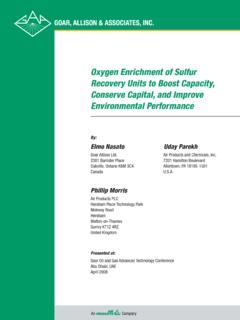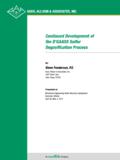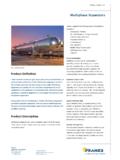Transcription of IMPROVING CLAUS SULFUR RECOVERY UNIT …
1 IMPROVING CLAUS SULFUR RECOVERY unit reliability through engineering design by Steve Fenderson GOAR, ALLISON, & ASSOCIATES, INC. Box 131390 Tyler, Texas 75713 Preprint of Paper to be given at the BRIMSTONE engineering SULFUR RECOVERY SYMPOSIUM September 15-18, 1998 IMPROVING CLAUS SULFUR RECOVERY unit reliability through engineering design TABLE OF CONTENTS INTRODUCTION 1 design BASIS 2 SRU design 2 PIPING 2 MAJOR EQUIPMENT 4 INSTRUMENTATION 19 SUMMARY 25 -1- Goar, Allison & Associates, Inc. INTRODUCTION In today s SULFUR RECOVERY unit (SRU) operating environment, greater emphasis must be placed on operating reliability than ever before.
2 Most environmental agencies are very reluctant to grant operating variances for conditions that would result in emission levels greater than permitted. Many companies are attempting to lengthen the time between scheduled maintenance shutdowns. Higher SULFUR feedstocks and additional hydroprocessing have used any excess SRU capacity that may have been initially installed. These factors all contribute to the importance of overall SRU operating reliability . Gone are the days when the primary reason for having an SRU was to satisfy the permit questionnaire and when little emphasis was placed on how efficiently or how much of the time the SRU actually operated.
3 Most environmental districts require complete emission monitoring reports, some districts even require on-line measurements be continuously sent to their offices, and violations require imme-diate action. It is imperative for the profitability of the refinery or gas plant that the SRU operate at very near 100% on-stream time. Overall SRU reliability can be increased through proper design methods and practices. Significant improvements in reliability can be achieved with a relatively modest increase in the initial capital cost of the SRU. However, many of the fea-tures that can be incorporated into a design are difficult and/or significantly more expensive to implement into an existing plant.
4 Therefore, it is extremely im-portant for the plant owner to insure the SRU is designed for optimum reliability at the earliest stage of design . This can be assured by either: 1. knowing that your designer will incorporate all practical features into the de-sign; 2. carefully specifying specific features that are to be incorporated into the de-sign (this is particularly important in fixed price bids), or 3. conducting regular detailed reviews, with approval, of all phases of the de-sign. -2- Goar, Allison & Associates, Inc. design BASIS The most important step in the development of any design is to establish a firm design basis as early in the project as possible and limit any changes in the de-sign basis to those areas that are absolutely necessary.
5 Items that should be established and incorporated into the design include: design feedstock including complete composition, temperature, and pressure, design processing capacity including any turndown/turn-up requirements, Specific processing requirements such as minimum SULFUR RECOVERY and prod-uct quality, The available utilities and any limitations on the conditions, availability, etc. of specific utilities, and Specific design features that should be incorporated. SRU design In this paper, we will present some of the ideas, opinions, and design standards that Goar, Allison & Associates, Inc.
6 (GAA) utilizes in the process engineering design of SRU s. GAA does not directly supply complete SRU s or equipment utilized in the construction of SRU s. Our engineering activities are generally lim-ited to the process design of the SRU. Therefore, we are more concerned with supplying a design that will be friendly to operate, will achieve expected process performance, and will operate reliably; rather than designing a plant that is the least expensive, but might not meet the other objectives. The SRU can be divided into three major design areas: (1) piping, (2) major equipment, and (3) instrumentation.
7 Each of these areas can greatly impact the overall performance and reliability of the SRU and is discussed below. The ideas presented are those of GAA and are not intended to be a complete listing of all possible arrangements and/or configurations. PIPING Piping design and layout is one of the most important aspects of the SRU design . The rules for piping design are relatively simple and will be discussed first. 1. Make all piping free-draining, 2. Keep piping runs as short as practical, 3. Keep all piping hot, but not too hot, 4. Steam jacket all liquid SULFUR lines, 5.
8 Utilize crosses at all direction changes in all liquid SULFUR lines, and 6. Slope all liquid SULFUR lines to promote draining. -3- Goar, Allison & Associates, Inc. These items may seem obvious, but we visit many plants in which some or even all of these rules have been violated. In general, these rules can be condensed into the basic overall SRU design rule of "keep it free-draining and keep it hot". The SRU is a vapor phase process unit other than the liquid SULFUR product. Any collection of liquids in piping can cause operating control problems, additional pressure drop through the SRU, equipment damage, and/or corrosion, etc.
9 It is particularly important that no liquid SULFUR be allowed to collect in piping where it could ignite with resulting personnel safety and equipment damage problems. The piping design should insure that any liquid will drain to a major equipment item, where it can be drained from the plant. Block valves should be located at high points to avoid liquid collecting against a closed valve. Keeping the pipe runs short and keeping the process hot compliment each other. It is easier to keep the process hot if the pipe runs are short, Uninsulated flanges and valves frequently causing problems.
10 These items literally act as air-cooling fins promoting condensation, corrosion, and plugging in the piping system. Flange sets and valves should have easily removable insulation covers that can be removed and reinstalled for maintenance activities. All lines containing am-monia and/or SULFUR vapor should use only steam jacketed control and block valves. The rules for liquid SULFUR lines are similar; "keep the runs short and keep them hot". However, for liquid SULFUR the rules are more stringent. SULFUR will freeze into a rock hard solid between 245-250 F.







